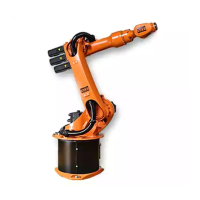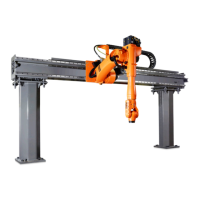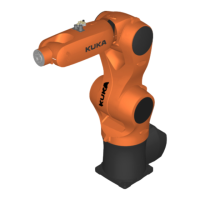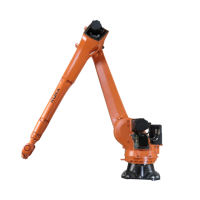8 Electrical installations
109 of 206
BA KR 6, 16 F, KR C4 12.10.07 en
8 Electrical installations
Information!
This description applies analogously to all of the industrial robots listed in Chapter 1,
regardless of the variant or model shown in the illustrations.
The electrical installations of the robot (manipulator) form a separate assembly. It includes
the “cable set” (Fig. 80), containing all the electric cables (Fig. 81 to Fig. 89). The cable set
has plug--and--socket connections so that exchanges can be quickly carried out. This dis-
penses with the need for wiring work.
The arrangement, designation and allocation of the cables may be noted from the various
diagrams. The connectors are provided with identification labels and coded. The ground con-
ductors are fastened with cable lugs to threaded bolts.
8.1 Description
Installed on the push--in module are the RDC box (Fig. 80/7) and the MFH (multi--function
housing) (3). Together with their connectors, these two housings form the interfaces with the
connecting cables.
The motor cables for axes 1 to 6 are grouped together in the multi--function housing (MFH)
(3) and are wired up to connector X30. This connector is at the same time the connector on
the robot for the connecting cable (motor cable) between the robot and the control cabinet.
The connector consists of six separate connector modules. Each connector module is as-
signed a particular motor connector (e.g. XM1).
The protective circuit is connected to terminals on the push--in module (2) on the base frame.
The control cables for axes 1 to 6 are grouped together in the resolver digital converter box
(RDC box) (7) and are connected to an RDC board (6). Each control cable has a separate
connector. The interface at the RDC box with the connecting cable (data cable) between the
robot and the control cabinet is formed by connector X31. Connector X32 is used for connect-
ing the EMD for the purpose of zero adjustment. Installed in the RDC box are the EDS (5)
and the RDC (6). Both components (boards) are connected by means of the EMS and RDC
cables.
A cable gland is fitted at the rear of the RDC box. From this gland, the cables are routed to
the base frame and from there via the common flexible tube A1 to the rotating column. The
flexible tube A1 ensures a low--stress routing of the supply lines as well as reducing the num-
ber of mechanical interface contours, without impairing the rotational motion of axis 1. The
cables for the drive units of axes 1 and 2 branch off in the rotating column.
The cables for the motor units of axes 3 to 6 run from the rotating column to the arm in a
flexible tube inside the hollow link arm. The flexible tubes prevent the cables from kinking.
The cables installed in the manipulator are summarized in tabular form in Fig. 79 and are
shown schematically in Fig. 80.

